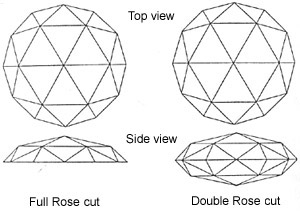Diamond cutting knowledge and skill has evolved slowly over the last 400 years. Early attempts to fashion diamond rough into sparkling gems were very difficult due to diamond's great hardness. During the 1800's and early 1900's, though, three import styles of cut were developed.
Rose cut
Its base is flat and its facets, which are in multiples of six, give it a flower-like appearance, like an "opening rosebud." This was the first multi-facet example of diamond and hinted at the gem's wonderful hidden beauty and brilliance.

Old Mine cut
By the nineteenth century, cutting had progressed further and what is now called the "Old Mine cut" became popular. It is really a precursor to today's popular round brilliant cut. The Old Mine cut differs from contemporary cuts in several ways. Although it has fifty-eight facets, the shape of the facets and the outline of the diamond are very different. These diamonds are somewhat rectangular in shape with a lumpier side profile. Facets generally lack proper symmetry, the table is very small, and the culet is extremely large (appearing more like a facet).

Old European cut
The next stage in the increasing sophistication of diamond cutting resulted in the "Old European cut", which appeared in the late 1800's. Like the Old Mine cut, it had a higher crown, small table and "open" culet. However, the Old European cut was round in shape, more symmetrical, the crown wasn't quite so high, nor the table as small as its predecessor. This style of cut exhibited more beauty and a better balance of fire and brilliance than the Old Mine cut.

to top
Valuation of old cuts
Although modern round brilliant cuts command a higher price per carat compared to older cuts, the demand and necessity for old cuts is critical. Old jewelry undergoing restoration in need of replacement diamonds require authentic matching old cuts. Antique rings with modern cut diamonds are less valuable and may be labeled as a reproduction. Antique dealers know that they must be willing to pay any price for a perfectly matching replacement estate diamond to get top dollar for their important jewelry. Because many old cut diamonds have been recut into modern cuts, supplies of these classic cuts are dwindling rapidly.